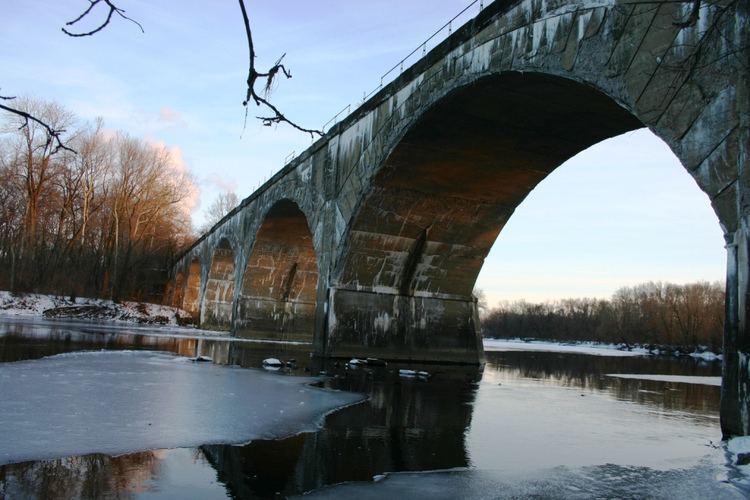 | ||
The Schuylkill Branch was a rail line owned and operated by the former Pennsylvania Railroad in the U.S. state of Pennsylvania. The line ran from the Philadelphia to Harrisburg Main Line at 52nd Street in Philadelphia north via Norristown, Reading, and Pottsville to Delano Junction (near Delano). From Delano Junction, the PRR had trackage rights over the Lehigh Valley Railroad's Hazleton Branch and Tomhicken Branch to Tomhicken, where the PRR's Catawissa Branch began. In conjunction with the Catawissa Branch, Nescopeck Branch, and Wilkes-Barre Branch, the Schuylkill Branch gave the PRR a direct line from Philadelphia to Wilkes-Barre.
Contents
History
Opened in 1884 to compete with the Reading Railroad for Philadelphia–Reading service, when the latter decided to compete with the PRR for Philadelphia-New York service, the Schuylkill Branch service primarily as a commuter rail line between Philadelphia and Norristown, with the lines being within plain sight of each other between Manayunk and Norristown. Service to Pottstown was made available in 1886, and an extension to New Boston (near Mahanoy City) was opened by the Pottsville and Mahanoy Railroad at around the same time. The final piece, from New Boston to Delano Junction, had been built by the Lehigh Valley Railroad before 1870, but this was leased by the PRR in 1885. In the 1930s, as part of the extensive electrification project that brought New York–Washington and Harrisburg–Philadelphia intercity passenger and through-freight service under wire, the Schuylkill Branch was electrified from its 52nd Street Junction in Philadelphia to Haws Avenue in Norristown.
With the surge in automobile sales and construction of extensions of the Pennsylvania Turnpike and the Interstate Highway System in Pennsylvania in the 1950s, the PRR eliminated commuter rail service in 1960 north of Manayunk, yielding Philadelphia, Norristown, and Reading commuter and through-passenger service to the rival Reading.
With the bankruptcies of the PRR's successor Penn Central and the Reading Company, the creation of Conrail in 1976 led to the closure and abandonment of the Schuylkill Valley Branch north of Manayunk. SEPTA, which took over the rail line in 1983, operated the former Conrail service as its Cynwyd Line rail service until 1986, when spalling conditions on the Manayunk Bridge concrete viaduct connecting the line between Bala Cynwyd and Manayunk/Ivy Ridge warranted its closure, forcing SEPTA to scale back service its Cynwyd Station in Bala Cynwyd. The viaduct has since been repaired and restored to its previous glory, though service has not resumed. SEPTA leased the unused section between Cynwyd and Ivy Ridge to local townships for used as an interim rail trail.
The Schuylkill Branch Today
While mostly abandoned, and since converted to a "rail trail" connecting Philadelphia with the Valley Forge National Historical Park near King of Prussia, Pennsylvania, a short piece at Norristown is used by the Norfolk Southern Railway (a part successor, along with CSX Transportation, of Conrail) as part of their Morrisville Connecting Track. The line between Oaks and Phoenixville is part of the currently unused NS Phoenixville Industrial Track. The Reading Blue Mountain and Northern Railroad owns the line from Temple (north of Reading) north to Hamburg. Additional sections of the trail completed are from slightly north of Reading Area Community College in Reading Pennsylvania to Gibraltar, Pennsylvania. The line is still in place from Gibraltar, Pennsylvania at Gibraltar Rd./ Rt.724 to Birdsboro, Pennsylvania and thus this portion of the trail is on road. The trail resumes where the railroad initially went underneath Rt. 724 in Birdsboro, Pennsylvania and continues to Pottstown, Pennsylvania. After Pottstown, one can access the trail again via a trailhead along rt 724 heading toward Phoenixville. Another section of the trail in northern Berks County, Pennsylvania includes a trailhead near the Reading Company Technical & Historical Society Railroad Museum in Hamburg, Pennsylvania to roughly the railroads Schuylkill River crossing near Auburn, Pennsylvania a few hundred yards before the branch crosses the Reading Railroad Mainline. The railroad then goes through a cut on private property and thus is not a trail yet. The trail resumes about 1/2 mile from the Schuylkill river crossing as the Bartram section of the Schuylkill River Trail. This section of the trail ends at the crossing of Rt. 895 West. On the other side of the road, the tracks are in place as the Auburn industrial which connects to the Reading & Northern Railroad via ex-Reading Railroad trackage. Since northern sections of the line were the first to be abandoned, at some places it is difficult to tell where the railroad right of way used to exist. In Schuylkill Haven, Pennsylvania, the right of way is still clearly visible along PA Route 61 North although no immediate plans are in place to turn this section into a trail. The catenary erected by the PRR is still maintained by Amtrak, as it powers both the Northeast and Keystone Corridors with electricity (except for the ex-PRR/Penn Central lines electrified prior to 1925) generated by the Safe Harbor Dam located near York, Pennsylvania.
The proposed Schuylkill Valley Metro, an electrified rail service that would have restored passenger service connecting Philadelphia and Reading, would have used the ex-PRR/Penn Central tracks from 52nd Street to Ivy Ridge, connecting with the existing ex-Reading Manayunk/Norristown service to Reading. Because of its rejection by the Federal Railroad Administration due to the high cost (primarily for electrification of the entire line and the need to literally rebuild the entire Philadelphia-Manayunk section of the Schuylkill Branch), alternate plans currently on the table only envision the use of the ex-Reading Manayunk/Norristown route only, with partial extension of the electrified service as far as King of Prussia, and any service west of King of Prussia requiring the use of push-pull consists using dual-power ALP-45DP locomotives similar to those delivered to New Jersey Transit and Montreal's AMT.
